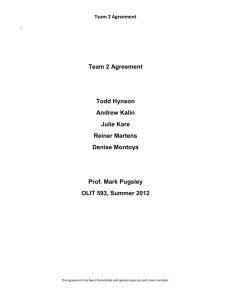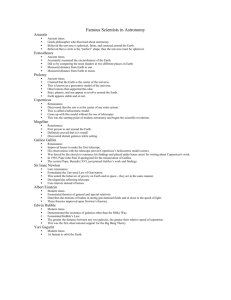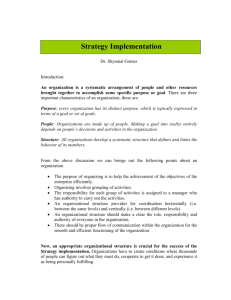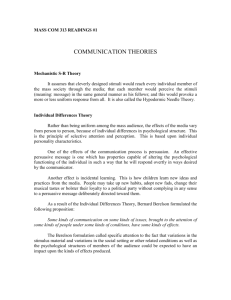Problem Formulation
advertisement
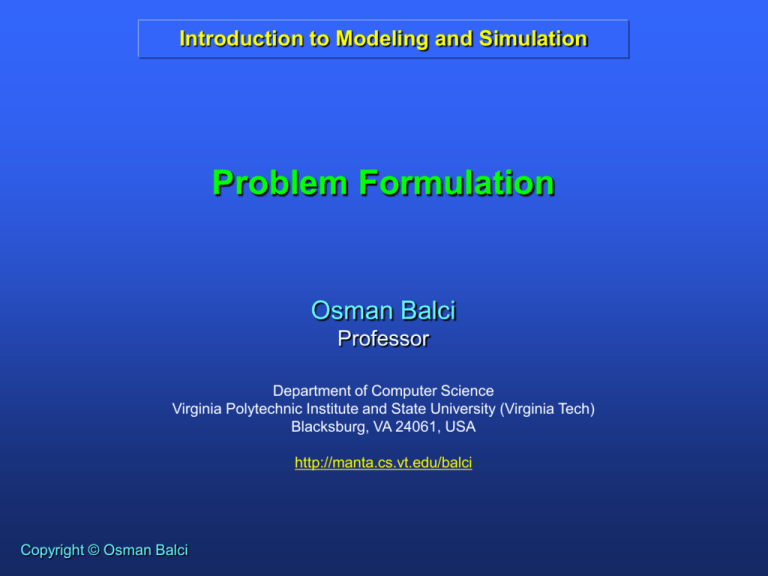
Introduction to Modeling and Simulation Problem Formulation Osman Balci Professor Department of Computer Science Virginia Polytechnic Institute and State University (Virginia Tech) Blacksburg, VA 24061, USA http://manta.cs.vt.edu/balci Copyright © Osman Balci Universe of Discourse V&V Repository of Certified Simulation Models Reuse QA Problem Formulation Formulated Problem V&V QA Requirements Specification Requirements Engineering V&V QA Storage Conceptual Model Conceptual Modeling V&V QA Architecture Specification Architecting V&V QA Certified Simulation Model Design Specification Design V&V QA Legend: Document Executable Submodels V&V Executable (Sub)Model QA Simulation Model Results V&V and QA Input Work Product Certification Implementation Integration V&V Process Iteration Maintenance Output Work Product QA Experimentation / Exercise / Use COI’s Responsibility Simulation Results V&V QA Organization ’s Responsibility M&S Life Cycle Copy right © Osman Balci Presentation Presented Results V&V QA Problem Formulation Universe of Discourse V&V QA Problem Formulation Formulated Problem V&V QA Example Universe of Discourse Universe of Discourse V&V QA Problem Formulation Formulated Problem V&V QA Example Universe of Discourse The universe of discourse refers to a specific problem domain for a Community of Interest (COI). For example, for the Ballistic Missile Defense (BMD) COI, the universe of discourse can be defined as a class containing all the entities referred to in a BMD discourse, or as an inclusive class of entities that is tacitly implied or explicitly delineated as the subject of a statement, discourse, or theory related to BMD. • Air Bourne Laser (ABL) Previous slide shows the elements of the BMD Universe of Discourse including the following: • Battle Management Command, Control, and Communications (BMC3) • Ground Based Radar-Prototype (GBR-P) • Ground-Based Interceptor (GBI) • Ground-based Midcourse Defense (GMD) • IFICS Data Terminal (IDT) • In-Flight Interceptor Communications System (IFICS) • Sea-based Midcourse Defense (SMD) • Space Based InfraRed System (SBIRS) • Space Based Laser (SBL) • Space Tracking and Surveillance System (STSS) • Theater High Altitude Air Defense (THAAD) • Upgraded Early Warning Radar (UEWR) • X-Band Radar (XBR) Example BMD COI For example, one BMD COI tries to model and simulate the trajectory of an exoatmospheric ballistic missile for the Intended Use of estimating the position of the missile after t time units given its current position. This estimation is critically important for deciding when to fire the ground-based or sea-based kill vehicle to intercept the incoming missile. Such simulation-based estimation is very complex since the trajectory is influenced by many factors including missile speed, gravity, temperature, composition of the missile hard body and its chemical interactions with atmosphere, and position of the sun and moon. Problem Formulation Universe of Discourse Problem Formulation (a.k.a. Problem V&V QA Structuring or Problem Definition) is the process by which the Universe of Discourse is analyzed to create a Problem formulated problem, which is sufficiently Formulation well defined to enable specific action. Formulated Problem V&V QA This process takes the Universe of Discourse description as input and produces the work product Formulated Problem as output. Problem formulation is the beginning of every problem solving methodology / project. The process of Problem Formulation is not given enough attention during the life cycle of conducting a project to solve a problem. The problem is educational. The accuracy of problem formulation greatly affects the acceptability and credibility of simulation results. Guidelines for Problem Formulation 1. Establish the problem domain boundary. a. A problem domain boundary is a logical and physical grouping of problem domain elements that will be taken into consideration. b. The boundary must be large enough to encapsulate all essential elements of the problem domain. 2. Gather data and information about the problem domain within the established boundary. 3. Identify the stakeholders and decision makers who would be interested in the solution of the communicated problem. 4. Specify the needs and objectives of the stakeholders and decision makers identified. 5. Identify and specify the constraints. 6. Specify all assumptions made clearly and explicitly. Formulated Problem Credibility and Quality Formulated problem credibility is the degree to which the formulated problem is believable. The formulated problem credibility assessment deals with the integrative evaluation of the quality of the formulated problem as a work product, the problem formulation process used in creating the formulated problem, the quality of people employed in problem formulation, and the project management characteristics (e.g., planning, resources, documentation) related to this life cycle stage. Formulated problem quality deals with the evaluation of how well the problem definition is structured and how completely and accurately the real problem is included in the problem definition. The most challenging task of problem formulation is to identify and specify the entire real problem. Three Scenarios and the Type III Error Scenario (1) represents the case where the formulated problem is completely disjoint from the real problem implying that the formulated problem is completely different than the real problem. Scenario (2) represents the case where the formulated problem contains only some parts of the real problem. Scenario (3) represents the ideal case where the formulated problem contains the entire real problem. Type III Error is the error of solving the wrong problem. It occurs in those cases represented by scenarios 1 and 2 above. When Type III Error occurs, the problem solution becomes irrelevant. Therefore, Type III Error is extremely important and its probability of occurrence must be kept as small as possible. Formulated Problem Credibility Assessment Indicators 1. (Probability of Type III Error) What are the chances that the real problem is not completely identified due to the possibility that a. People might have personalized problems? b. Information showing that a problem exists might not have been revealed? c. The problem context is too complex for the analyst to comprehend? d. Root problems might have arisen in contexts with which people have had no experience? e. Cause and effect may not be closely related within the problem context? f. The analyst might have been unable to distinguish between facts and opinions? g. The analyst might have been misguided deliberately or accidentally? h. The level of extraction of problem context was insufficiently detailed? i. The problem boundary was insufficient to include the entire real problem? j. Inadequate standards or definition of desired conditions exist? k. The root causes might be time dependent? l. A root cause might have been masked by the emphasis on another? m. Invalid information might have been used? n. Invalid data might have been used? o. Assumptions might have concealed root causes? p. Resistance might have occurred from people suspicious of change? q. The problem was formulated under the influence of a solution technique? r. The real objectives might have been hidden accidentally, unconsciously, or deliberately? s. Root causes might be present in other unidentified systems, frameworks, or structures? t. The formulated problem may be out of date? Formulated Problem Credibility Assessment Indicators 2. 3. Stakeholders and Decision Makers a. Do you know or can you think of any stakeholders and decision makers, other than the ones identified by the analyst, who might be aided by the solution of the problem? b. Are all Active Stakeholders (e.g., users of the solution system, administrators of the solution system, trainers of the solution system users) identified? [An active stakeholder is the one who will actively interact with the solution system once it is operational and in use.] c. Are all Passive Stakeholders (e.g., developers, decision makers about the use of the solution system, logistics personnel, manufacturer, owners/sponsors if they don't use/operate the solution system) identified? [A passive stakeholder is the one who will not actively interact with the solution system once it is operational and in use.] Constraints a. Do you know or can you think of any other constraints which should have been identified by the analyst? b. Are there any incorrect or irrelevant constraints? c. Are there any constraints which make the formulated problem infeasible to solve? Formulated Problem Credibility Assessment Indicators 4. Objectives a. How well are the objectives stated? b. Do you believe any objectives to be inconsistent, ambiguous, or conflicting in any way? c. How realistic are the objectives? d. Are there any priorities specified for the case where only some of the objectives are achievable? e. Do you know or can you think of any relevant stakeholders and decision makers whose objectives are conflicting with any of those specified? f. In case of multiple objectives, do you agree with the way the objectives are weighted? g. Do you agree that the stated objectives are the real objectives of the stakeholders and decision makers involved? h. Do you know or can you think of any associated objective which is disguised or hidden either accidentally, unconsciously, or deliberately? i. How often could the stated objectives change? Formulated Problem Credibility Assessment Indicators 5. 6. Data and Information a. Are there any sources of data and information used by the analyst that you believe to be unreliable? b. Are there any data and information used by the analyst that you believe to be out of date or need to be updated? c. Are there any data and information which you believe to be not sufficiently accurate? Assumptions a. How well are the assumptions stated? b. Are there any invalid assumptions based on which the problem is formulated? c. Are there any invalid inferences or conclusions drawn by the analyst?

